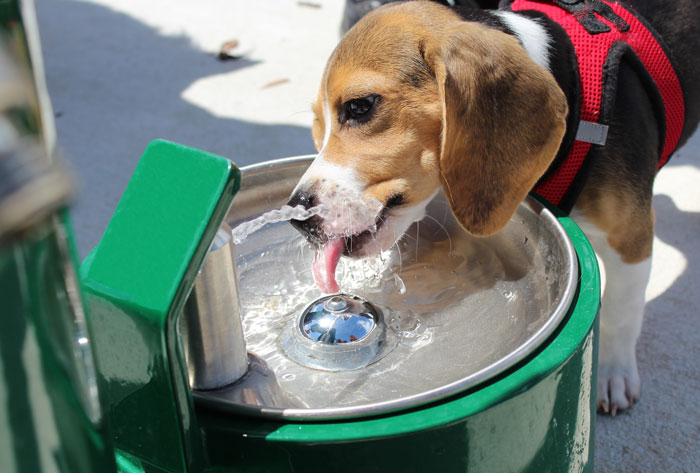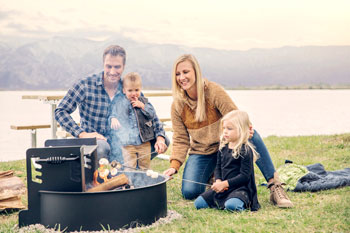
Beyond the beauty and attractiveness of surrounding nature and the sheer magnitude of a well-maintained park, having an assortment of modern site furnishings on hand can add immeasurably to the visitor experience, park designers and manufacturers say.
But, given the many options municipal park managers have, the question becomes not only what furnishings are appropriate, but also what are the best ways to arrange those furnishings in the space?
Park planners should carefully consider the types of furnishings that cater to the diverse needs and activities of their community, suggested Mimi Marler, marketing manager at a Red Bud, Ill., furnishings manufacturer. “The key,” she said, “is to create a versatile environment that is welcoming to people who gather regularly. Whether it’s an extension of a school cafeteria or a shaded spot under a picnic shelter at your local park, the design should be centered around usability and convenience.”
During project planning, it’s crucial to envision various scenarios and understand how patrons will use the area, Marler continued. “For example, if the area is likely to attract a significant number of bike riders, it’s essential to provide ample bike parking. Adjacent to the bike parking, consider placing benches for those who may need to change their shoes or take a break after a long ride.”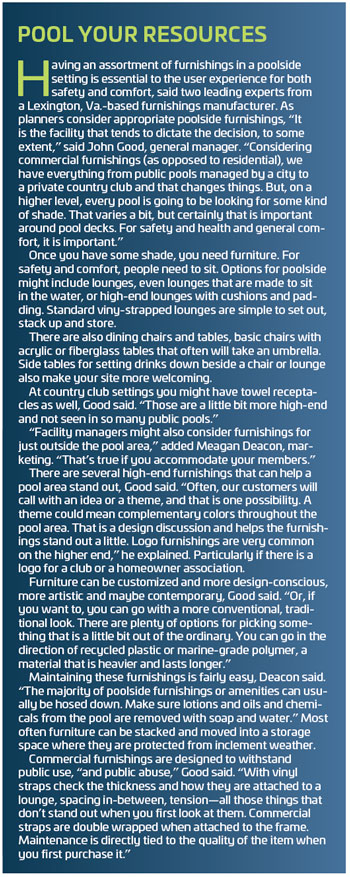
Parks should always have trash and recycling receptacles near the entrance to the park or the entrance to a trail, said Adam Struck, marketing manager for a Cherokee, Iowa-based furnishings manufacturer. This is where most of the litter happens, he said. “Receptacles should also be placed near any seating area, whether it be a bench on a trail or a picnic area.”
Picnic areas are ideally on a flat surface where there is a view or something that attracts visitors to want to sit in that area. A grassy area works well, especially for families with children.
Consider taking a thoughtful approach to the outdoor pavilion area, Marler said, for this is a great multigenerational space where friends and families can gather and make memories together. “To ensure a vibrant, user-friendly environment, it is important to think about accessibility, from start to finish,” she said. “These spaces are best served where parking is convenient, and to ensure accessibility by incorporating tables designed for all, including those with mobility devices. Pay close attention to layout, providing an accessible route and avoiding overcrowding. Adequate spacing between tables fosters a welcoming environment and allows for easy movement. You will also want to be sure to provide strategically placed trash receptacles to promote responsible waste disposal. Pay close attention to the park layout, and where furnishings are best situated.”
When it comes to a municipal park, public area or parklet, having the right amenities for the public is critical not just for functionality, but also for safety, added Marilee Gray, marketing director for a Janesville, Iowa, company that offers furnishings (and even games) for parks. “Public areas take a beating,” she said.
“It’s not just the wear and tear of weather. It could be the runaway bike, if it is not locked up on a bike rack, an errant skateboard or a bunch of rough-and-tumble teens that bump, bang or thump the trash receptacle, game table or park bench. That’s when choosing the right outdoor furniture comes into play.”
That’s why public safety is paramount when planning how you’re going to decorate the space, Gray noted. “How many times have you seen people sitting on top of a picnic table? This is when strength and durability become so important. No one wants to see anyone get injured from a faulty table or cheap materials.”
Create a Setting
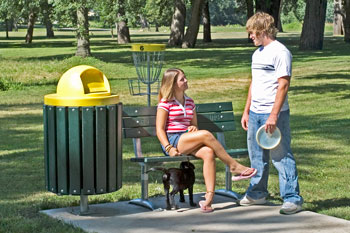
Quite simply, said Geoffrey Munro, creative director of a Naperville, Ill., outdoor equipment provider, “The idea of site
furnishings is to enhance spaces for visitors to enjoy the experience with the surrounding environment.”
The right place for benches and picnic tables? Where people will use them, he said. “Convenience to activities, attractions and nearby parking can be a plus. Shade of some sort is always welcomed, whether natural or manufactured. The size of the installation area will determine how many tables can be placed.”
Also, make sure there is space for visitors to easily maneuver in and around. Universal access should be a consideration, and these days, you can find a matching universal design for many of the tables in furnishing providers’ lineups.
Park benches are best placed along paths to encourage those who might need rest stops to explore more of a park, Munro said. “Locations that have scenic views are always preferred, as well as nearby activities such as playgrounds or sport courts. Of course, in spaces where visitors will most likely be waiting it’s always a nice thing to
have a place to sit.”
Trash receptacles are the most effective way to help maintain a litter-free environment. Placing them in areas that make it most convenient for visitors to use goes a long way in encouraging proper waste disposal, Munro explained. “When considering size, the two major factors are traffic volume versus servicing schedule. Take into account that they should be far enough away so that potential pests don’t become unwanted guests at seating areas. Placing receptacles at transition points such as entryways is also a good practice so visitors coming and going can easily dispose of waste they may be carrying.”
Be Unique
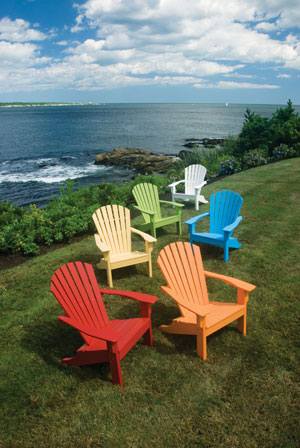
For parks seeking to stand out, personalized furnishings and creative signage can bring a unique touch to the
environment. Imagine benches with personalized engravings or picnic tables with game tops. Integrating such personalized elements adds a distinctive charm and fosters a sense of ownership among park-goers.
“Dynamic seating options, like swinging benches, create a playful atmosphere, encouraging visitors to relax and socialize,” Marler said. Creative and thematic signage not only serves as wayfinding but also contributes to the park’s character. Think about incorporating signs with historical facts, local anecdotes or even “interactive QR codes that provide additional information,” Marler suggested.
“This not only informs visitors but also enhances the overall experience, making the park more than just a recreational space. By focusing on personalized furnishings and engaging signage, parks can create a one-of-a-kind atmosphere that resonates with the community. These thoughtful details not only set the park apart but also contribute to a welcoming and community-centric space, making it a destination that leaves a lasting impression on all who visit.”
Struck agreed, and noted that customization is becoming more and more popular. “Some parks request laser-engraved lettering or logos on the side of fire rings,” he said. “There are many customization options for picnic tables and benches. Plaques, engraving, signage and multiple color patterns are all options. Parks can be creative with bike racks; they come in many different colors, shapes, designs and sizes. There are bike racks that are designed to look like a bike, or others that have laser-cut custom designs incorporated in them.”
The majority of parks stick with basic browns and greens for tables and benches, Struck said. “We have had a few parks recently trend toward a more colorful look. Thermoplastic-coated steel offers a wide range of color choices to choose from. Red, light green, orange, blue, yellow are just some of the brighter colors available.”
One new product trend Munro mentioned are solar charging stations. “It’s still an emerging concept,” he said, “so the variety of options is not vast yet, but I can see it becoming more and more popular. I have seen some very cool stand-alone stations and benches that incorporated the solar panels into the seat. The beauty is there is no need to run electricity to the station.”
Selecting the Right Materials
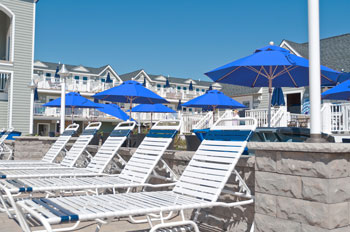
One of the main features of just about every site furnishing product is its durability, Munro noted. “They are pretty much
all engineered to stand up to high-volume use in all-weather conditions. There are some ambient environmental factors to consider. Coated metal products are very durable and come in a variety of shapes, sizes and colors. However, grainy substances like salt and sand can lead to chips and cracks—so coated metal is not ideal for areas like beaches or near the ocean. With outdoor environments there are a variety of elements that can collect on site furnishings that over time can have adverse effects—simply washing with soap and water at proper intervals will prevent these elements from building up and causing issues.”
Picnic tables built from softwoods like Douglas fir and cedar are popular because they’re inexpensive and readily available, Munro said. Regular refinishing is needed to protect wood against fading, rot, insects and moisture retention. Softwoods are often less durable than hardwoods and can be easily dented or scratched. Wood stays at a comfortable temperature in hot and cold weather. Munro explained that hardwoods like teak, oak and mahogany typically offer higher strength and durability than softwoods, making them ideal for outdoor tables. Hardwoods are more resistant to fading, rot, moisture and insects than softwoods but still need regular refinishing for protection. The strength of hardwood makes it resistant to scratches and dents.
Aluminum is a low-maintenance and inexpensive metal option that is tough, resilient and easy to maintain, Munro added. It is “highly resistant to fading, pests and rust. It requires regular treatment to stave off corrosion.
“Coated metal is another material. For example, steel coated in plastic, either as a veneer or powder that’s fused to the metal’s surface,” Munro said. “It is very durable and resistant to dents and scratches and has a higher resistance to rust and corrosion. One drawback is that extreme temperatures and grainy substances like dirt or salt can lead to chips and cracks.”
Galvanized steel is dipped in a molten zinc bath to give the steel a thin coating for corrosion protection. That gives it a
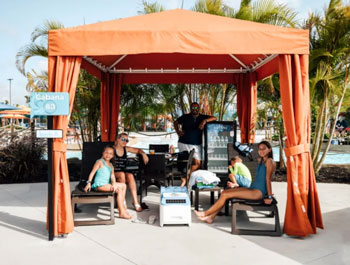
rugged appearance and the trademark shiny pattern known as “spangle.” The general result is similar to stainless, but widely varies depending on the vacillations of the process, Munro explained. “Stainless steel is a low-carbon steel containing chromium, which gives the steel a distinctive stainless, corrosion-resisting property. The steel can be polished or electro-polished for an extremely glossy, mirrored metal appearance. Its antimicrobial finish is extremely resistant to fire and heat, and is highly durable in harsh weather conditions.”
Meanwhile, high-density polyethylene (HDPE) is a type of plastic known for its durability and is weather-, rust-, and corrosion-proof. “The lumber is sturdy and resistant to fading stains. It requires minimal cleaning and upkeep. If you want a sustainable option, look for HDPE products made using recycled plastics,” Munro said.
Concrete is an option as well. “Concrete products start with a skeleton of steel or a welded rebar cage that is then encased in concrete,” Munro said. “This makes concrete one of the most versatile and durable construction materials available. The sheer weight and material of these tables makes them nearly impossible to steal or vandalize.”
Maintaining Your Furnishings
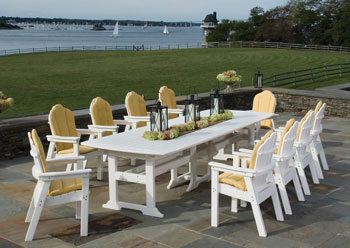
“Environment plays a big role in material selection,” Struck said. “Parks in coastal areas have to worry about salt and the damage it can do. Recycled plastic and stainless-steel products are better suited for those areas. Galvanized table frames are a better option and will hold up longer to those elements than a powder-coat frame.
“Parks in very high elevations that can get 10 to 20 feet of snow need to consider snow-load-rated picnic tables and fire
rings,” Struck continued. “People would be surprised at the damage done after 15 feet of snow sits on a table for the winter on a standard picnic table.”
Vandalism is also a consideration, Struck said. Kids jumping on a bolt together, a thin frame with weak welds on the tabletop and seats will not last very long compared to a welded, 2 3/8 inch outside diameter frame with a sturdy thermoplastic-coated steel top and seats.
“Fire rings and grills are manufactured with different steel thickness, different strengths of grates,” Struck said. “There are fire ring grates that can withstand two large adults jumping on them, and others that will be ruined with one adult standing on them. Grill maintenance is an area often overlooked. The longevity of a park grill is largely dependent on the maintenance done to them. If sediment or used coals are left sitting in the fire box exposed to the elements (rain), the corrosion of the steel will be greatly accelerated.
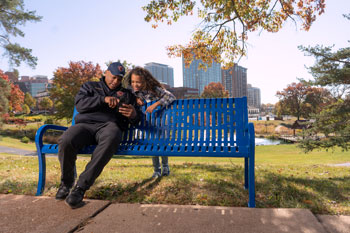
“I always recommend that parks ask for samples,” Struck said. “Products can appear to have the same specs on paper, but when samples of the product are in front of them it may be a completely different story. Know what you are purchasing.”
All outdoor furniture requires some level of maintenance, Marler said. Park managers should conduct thorough checks for wear, loose hardware or vandalism at least every six months. High-use areas might need more frequent inspections to address potential issues promptly. Swift replacement of broken or worn parts is vital, as damage from wear can pose safety risks.
“There are many material types on the market these days when it comes to outdoor furnishings,” Marler said. “Most of
these are pretty comparable, but the specialty woods are the ones to watch out for, many of these products do have special maintenance requirements, it is important to consider this upkeep when selecting your product.”
All products that are used in public spaces can be subject to misuse. The beauty of thermoplastic-coated products is the relative ease of removing unwanted graffiti from the surface. “We have found that the affected area can be sprayed with various penetrating fluids like WD-40 to dissolve the ink or paint without damaging the original finish,” Marler explained.
In general, these types of fixes can be done on site, but that may not be the case depending on the severity as well as the material of the product. Be sure to contact your supplier and they will be happy to walk you through the best maintenance solutions for your circumstance. RM



